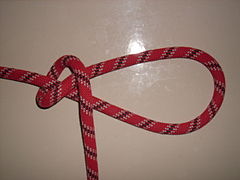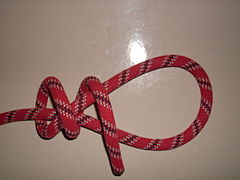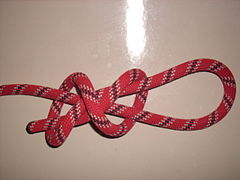Cave knot
| Cave knot | |
|---|---|

|
|
| Type | Noose and mooring line |
| application | Rope on snap hook |
| Ashley No. | 409, 1228 |
| Synonyms | double spar stitch |
| English | Double overhand noose |
| List of nodes | |
The cavity node is a node from the caving.
Names and history
This knot is used by French and Austrian speleologists and is becoming more and more popular in Germany and Switzerland. In nautical science, two of these knots are used to connect equally strong ends as a double spar stitch . This is why cave explorers sometimes call it a spar stitch loop or demi pêcheur double .
application
The cave knot (also known as the spar stitch loop) is used to attach the static rope or dynamic rope to the snap hook . The hook is fixed in the knot in such a way that it does not move and can therefore be handled more easily. It is not used for roping up .
This can also be used to create quickdraws or short loops for self-belaying, called “lunge” in cave exploration. In France, such longs were examined for breaking load , impact force and knot strength . The cave knot has the lowest impact force values and is therefore best suited for self-belaying.
Knot
The cave knot is a two-strand ribbon knot with two (instead of three) windings, it consists of a double overhand knot around the fixed end and can be tied in different ways.
Alternatives
- The climbers use the figure of eight knot to attach to the carabiner .
- Self assurance carabiner also is clove hitch used.
- If the knot on the carabiner is to be detachable under tension, the mountain rescue knot is used.
- Sailors use the shackle to Buntline Hitch .
- To include a thimble serving two-strand Bändselknoten .
Modifications

- A triple overhand knot is used to tie in a thimble and is called a two-strand ribbon knot .
- Tied with two ropes, it is one half of the double spar stitch .
- Without a loop it becomes a double overhand knot .
- If an object is tied in instead of a loop, this corresponds to the Strangleknot according to ABoK # 1239 .
Individual evidence
- ↑ Campagne de tests sur les longes utilisées pour les déplacements sur cordes semi-statiques. (PDF) 2006, archived from the original on November 4, 2009 ; Retrieved on February 19, 2016 (French).





